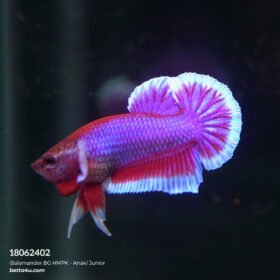Tips For Keeping Multiple Betta Fish in a Single Tank
Keeping multiple betta fish in a single tank is a fascinating and rewarding endeavor that, when done correctly, can lead to a beautiful and harmonious aquatic environment. However, it requires careful planning and understanding of betta behavior and needs. This guide will provide you with essential tips to ensure the successful cohabitation of multiple bettas, particularly females, in a single tank.

Only Female Bettas Can Live Together
Betta fish, also known as Siamese fighting fish, are renowned for their vibrant colors and striking fins. However, they are also known for their aggressive behavior, especially males. Understanding the temperament of betta fish is crucial when considering keeping multiple bettas in one tank. Males are highly territorial and will often fight to the death if placed together. On the other hand, female bettas, while still possessing a hierarchical social structure, are generally more tolerant of each other and can live together in what is known as a sorority.
When selecting female bettas for your tank, it's essential to choose fish of similar size and temperament. Introducing new females should be done carefully to avoid upsetting the established hierarchy. It's also beneficial to introduce all the fish at the same time to reduce initial aggression and territorial disputes.
Create a Homey Tank
Creating a comfortable and stimulating environment for your bettas is key to reducing stress and promoting healthy interactions. The tank size is a critical factor; a minimum of 20 gallons is recommended for a betta sorority, with additional space needed for each extra fish. Larger tanks provide more space for each fish to establish its territory, reducing the likelihood of conflict.
Incorporate natural decorations such as live plants, rocks, and driftwood to create hiding spots and break up lines of sight. Bettas enjoy exploring their environment, and having plenty of hiding places will help them feel secure and reduce stress. Plants like java fern, anubias, and water wisteria are excellent choices as they provide cover and help maintain water quality.

Be Sure to Feed Your Fish Enough
Proper nutrition is vital for the health and well-being of your bettas. Betta fish have specific dietary needs and thrive on a varied diet of high-quality pellets, frozen or live foods such as brine shrimp and bloodworms. Feeding should be done twice a day in small amounts that can be consumed within a few minutes to prevent overfeeding and maintain water quality.
It's important to ensure that all fish are getting enough food. In a community tank, some bettas may dominate feeding times, leaving others hungry. Observing your fish during feeding times and using a feeding ring or different feeding spots can help ensure that all your bettas receive adequate nutrition.
Keep a Close Eye on How They Interact
Monitoring the behavior of your bettas is essential to maintaining a peaceful tank environment. While female bettas can coexist, they will establish a pecking order, and occasional squabbles are normal. However, persistent aggression, fin nipping, or signs of stress such as hiding, lethargy, or loss of appetite indicate that intervention is needed.
If you notice any signs of serious aggression or bullying, it may be necessary to temporarily separate the aggressive fish. This can be done using a breeder box or a divider within the tank. Allowing the fish to calm down and reintroducing them gradually can help restore harmony. Always be prepared to remove a fish permanently if it continues to be a problem.
Put Filler Fish in the Tank to Distract Bettas
Adding non-aggressive filler fish to the tank can help diffuse aggression among the bettas by providing distractions and additional activity. Suitable filler fish include peaceful species such as neon tetras, guppies, and corydoras catfish. These fish not only add visual interest to the tank but also help to create a more dynamic environment.
When introducing new fish, it's crucial to do so gradually and observe how the bettas react. Acclimate the new fish properly to avoid stress and ensure they have hiding places to retreat if necessary. The presence of other species can help to spread out the bettas' attention and reduce intra-species conflict.
Keep a Quarantine Tank Available
A quarantine tank is an essential part of any fishkeeper's setup. It serves as a place to isolate new fish before introducing them to the main tank and a safe haven for sick or injured fish. A quarantine tank can help prevent the spread of diseases and parasites that could potentially devastate your entire community.
Setting up a quarantine tank is relatively simple. A small tank of 5 to 10 gallons with a sponge filter, heater, and hiding spots is sufficient. New fish should be kept in quarantine for at least two weeks, during which time they can be observed for signs of illness. Regular water changes and monitoring are crucial during this period. If any fish in the main tank show signs of illness, moving them to the quarantine tank for treatment can prevent the disease from spreading.
FAQs
Can male and female bettas live together in the same tank?
While it is possible to keep male and female bettas together in very large tanks with plenty of hiding spots, it is generally not recommended due to the high risk of aggression. Male bettas are territorial and may attack females, especially during spawning.
How many female bettas can live in a single tank?
A good rule of thumb is to keep at least five female bettas together in a tank of 20 gallons or larger. This number helps to spread out aggression and establish a stable hierarchy. More space and hiding spots will allow for a larger group.
What should I do if my bettas are fighting?
If your bettas are showing signs of serious aggression, such as constant chasing, fin nipping, or injuries, it may be necessary to separate them temporarily. Use a divider or a separate tank to give them time to calm down before reintroducing them.
Can I add new bettas to an established tank?
Adding new bettas to an established tank can be challenging. It is essential to quarantine new fish and introduce them gradually. Monitor the tank closely for signs of aggression and be prepared to intervene if necessary.
What types of filler fish are best for a betta tank?
Peaceful and non-aggressive fish like neon tetras, guppies, and corydoras catfish make excellent filler fish for a betta tank. These species are small, fast, and unlikely to provoke aggression from the bettas.
How often should I clean my betta tank?
Regular maintenance is crucial for a healthy betta tank. Perform partial water changes of 20-30% weekly, clean the substrate, and remove any uneaten food or debris. Keeping the tank clean helps to prevent diseases and maintain water quality.
Conclusion
Keeping multiple betta fish in a single tank can be a rewarding experience, offering a vibrant and dynamic aquatic display. By understanding the specific needs and behaviors of bettas, creating a suitable environment, and monitoring their interactions, you can ensure a harmonious and healthy community tank. Remember, the key to success lies in careful planning, regular maintenance, and a keen eye for any signs of trouble. With the right approach, your betta tank will thrive, providing endless enjoyment and beauty.
REFERENCES
6 Things to Know Before Putting Two or More Betta
Mastering Fish Grooming: A Guide to Enhancing Your Aquatic Pets’ Growth and Form






